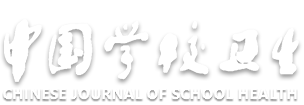Physical fitness of college freshmen in one college in Xi'an during 2005-2018
-
摘要:
目的 了解西安市2005—2018年某大学新生体质变化特征,为促进大学生体质发展提供参考和依据。 方法 选取西安市某省属重点高校2005—2018年47 047名新生体质量指数(BMI)、肺活量和耐力素质测试数据,依据《国家学生体质健康标准》对3项指标进行分类,分别采用描述性统计和t检验进行分析。 结果 2005—2018年间,某大学男、女新生BMI、肺活量和耐力素质均值分别为(21.69±3.26)(20.88±2.65)kg/m2;(418 9.59±788.57)(2 815.06±572.07) mL;(246.17±24.09)(239.97±20.23)s,性别间差异均有统计学意义(t值分别为29.48,218.87,28.70,P值均 < 0.05),各年份3个指标之间差异均有统计学意义(F值分别为104.82,185.43,40 891.99,P值均 < 0.05)。男、女新生BMI和肺活量均值在过去14年间总体上在曲折中上升;耐力则呈现“V”型变化趋势,2009年为显著拐点。 结论 2005—2018年,大学新生BMI和肺活量呈现上升趋势,而耐力素质自2009年后持续下降。应及早关注并干预大学新生BMI的上升和耐力素质的下降状况,减小未来的疾病风险,促进健康关口前移。 Abstract:Objective To understand changes of physical fitness, among college freshmen in one college in Xi'an from 2005 to 2018. Methods Body mass index (BMI), vital lung capacity and cardiorespiratory endurance test data from 47 047 freshmen from 2005 to 2018 were included and analyzed. BMI, vital lung capacity, and cardiorespiratory endurance were classified according to the National Student Physical Fitness and Health Standard. Descriptive statistics, t test was used in the data analysis. Results Mean BMI, vital lung capacity and cardiorespiratory endurance for male and female were (21.69±3.26) (20.88±2.65) kg/m2, (4 189.87±788.57) (2 815.06±572.07) mL, (246.17±24.09) (239.97±20.23) s, respectively, all of which had significant statistical differences (t=29.48, 218.87, 28.70, P<0.05). Physical fitness indicators showed significant differences over the years (F=104.82, 185.43, 40 891.99, P<0.05). Mean BMI and vital lung capacity in male and female freshmen showed nonlinear increase trend across the past 14 years, while endurance showed a "V"-shaped change with a significant inflection point in the year of 2009. Conclusion From 2005 to 2018, BMI and vital lung capacity showed an upward trend, and cardiorespiratory endurance quality continued to decline since 2009 among college freshmen. -
Key words:
- Body constitution /
- Body mass index /
- Vital capacity /
- Growth and development /
- Students
-
体质是健康的“上游”影响因素,在预防疾病、促进健康中发挥着重要作用[1-2]。然而,近30多年来学生体质持续下降,尤其是大学生体质更不容乐观[3-5]。《国务院关于实施健康中国行动的意见》[国发2019][6]13号文件明确提出,落实预防为主方针,实施健康中国行动,提高全民健康水平。学生体质促进成为细化和落实“预防为主”方针的重要举措。
大学生体质促进工作的有效开展建立在对新生体质精准了解和把握的基础上。因为新生体质测试往往在入学后的9—10月份进行,因此,测试结果既是大学体育教育的起点,也是体质促进工作的重要依据。本研究从西安市某省属重点高校新生连续14年的体质测试数据中,选取测试内容和测试标准相对稳定的体质量指数(BMI)、肺活量和耐力3个指标进行分析,旨在探索各变量历年变化特征,从而为高校体育和大学生体质促进工作的开展提供参考和依据。
1. 资料来源与方法
1.1 资料来源
选取西安市某省属重点高校连续14年在校大一新生体测数据共49 520例,剔除无效数据和极端数据2 473例,最终分析数据4 7047例,其中男生28 150例(59.8%),女生18 897例(40.2%)。经该高校体育部门知情、允许并提供,数据得以收集和分析。
1.2 方法
BMI、肺活量和耐力3个指标在历年体质测试中均由专门工作人员按照《国家学生体质健康标准》[7]进行测试。耐力项目测试内容为男生1 000 m跑,女生800 m跑;数据整理时,每项素质既保留了原始测试值,同时根据《国家学生体质健康标准》中的单项素质评分表及分类标准对原始测试值进行评分,再依据肺活量和耐力评分等级将其均划分为优秀、良好、及格、不及格4个等级,分别对应≥90,80~89,60~79,<60分,BMI也依据上述标准划分为偏轻体重、正常体重、超重和肥胖4个等级,分别对应≤17.8 kg/m2(≤17.1 kg/m2, 女生)、17.9~23.9 kg/m2(17.2~23.9 kg/m2, 女生)、24.0~27.9 kg/m2、≥28.0 kg/m2。
1.3 统计学分析
采用SPSS 22.0软件对数据进行统计分析。各项体质测试数据采用(x±s)表示。采用独立样本t检验进行性别间比较,采用方差分析进行年度间比较,检验水准α=0.05。
2. 结果
2.1 大学新生BMI、肺活量和耐力素质基本特征
2005—2018年,男、女新生BMI、肺活量和耐力素质均值分别为(21.69±3.26)(20.88±2.65)kg/m2;(4 189.59±788.57)(2 815.60±572.07)mL;(246.17±24.09)(239.97±20.23)s,性别间差异均有统计学意义(t值分别为29.48,218.87,28.70,P值均<0.01)。除2005和2010年外,不同性别新生BMI差异均有统计学意义(t值分别为2.95,14.30,P值均<0.05);2006—2018年,不同性别新生肺活量成绩差异均有统计学意义(t值分别为45.99,82.76,P值均<0.01);除2010年外,其余年份不同性别耐力成绩差异均有统计学意义(t值分别为2.00,17.47,P值均<0.05),3个指标在各年度之间差异均有统计学意义(F值分别为104.82,185.43,40 891.99,P值均<0.05)。见表 1。
2.2 大学新生BMI、肺活量和耐力素质变化趋势
男、女新生BMI和肺活量均值在过去14年间总体表现在曲折中上升,而耐力变化则呈现“V”型变化趋势,2009年为显著拐点。见表 1。
表 1 某高校2005—2018年不同性别新生BMI、肺活量和耐力比较Table 1. The characteristics of BMI, vital lung capacity and cardiorespiratory endurance in college freshmen from 2005 to 2018年份 性别 人数 BMI/(kg·m-2) 肺活量/mL 耐力项目/s x±s t值 P值 x±s t值 P值 x±s t值 P值 2005 男 1 097 21.14±2.68 0.85 0.40 3 355.01±935.93 0.55 0.58 256.00±24.41 3.07 0.00 女 586 21.03±2.72 3 323.89±917.04 252.61±19.94 2006 男 1 096 21.08±2.56 8.60 0.00 3 914.78±659.54 45.99 0.00 248.92±25.81 5.95 0.00 女 546 20.09±1.98 2 523.55±531.94 242.32±18.43 2007 男 990 20.95±2.43 2.95 0.00 3 847.34±643.09 48.53 0.00 242.73±18.58 5.14 0.00 女 651 20.61±2.16 2 540.11±447.56 238.10±16.71 2008 男 1 276 21.04±2.94 4.81 0.00 3 688.28±695.79 49.50 0.00 245.06±24.17 5.17 0.00 女 791 20.47±2.33 2 389.86±494.18 240.34±17.24 2009 男 1 364 20.75±2.42 4.30 0.00 4 005.16±610.23 58.22 0.00 235.03±17.30 5.90 0.00 女 868 20.32±2.22 2 695.25±449.93 230.83±15.82 2010 男 1 739 20.69±2.42 0.80 0.07 4 056.01±692.16 58.78 0.00 237.58±18.80 -0.14 0.89 女 1 077 20.52±2.29 2 717.80±511.38 237.68±17.94 2011 男 2 446 20.81±2.49 4.39 0.00 4 160.03±639.45 75.90 0.00 242.66±20.36 2.00 0.05 女 1 448 20.47±2.24 2 779.03±487.15 241.44±17.39 2012 男 2 753 21.76±2.65 8.80 0.00 4 261.16±637.37 82.76 0.00 - 女 1 746 21.10±2.32 2 870.58±485.06 - 2013 男 2 877 21.76±3.40 14.05 0.00 3 996.97±721.27 76.99 0.00 247.21±28.03 4.13 0.00 女 1 754 20.49±2.67 2 539.25±558.22 243.90±25.49 2014 男 2 621 21.99±3.44 10.68 0.00 4 238.08±685.38 81.73 0.00 250.00±27.17 9.90 0.00 女 1 837 21.03±2.58 2 835.47±460.18 247.13±28.17 2015 男 2 265 22.21±3.36 10.87 0.00 4 235.75±735.70 71.42 0.00 243.92±22.82 9.05 0.00 女 1 827 21.18±2.73 2 845.84±505.28 237.98±19.15 2016 男 2 522 22.16±3.92 10.33 0.00 4 257.58±721.16 77.29 0.00 249.80±23.60 13.89 0.00 女 1 834 21.11±2.91 2 819.13±506.99 240.74±19.36 2017 男 2 613 22.79±3.79 11.62 0.00 4 734.70±823.36 80.72 0.00 249.48±22.81 17.47 0.00 女 2 003 21.62±3.03 3 066.32±579.34 239.53±19.70 2018 男 2 491 22.32±3.86 14.30 0.00 4 704.84±803.50 79.35 0.00 247.80±24.71 16.58 0.00 女 1 929 20.85±2.99 3 036.00±593.59 236.83±19.26 3. 讨论
本研究分析了2005—2018年西安市某省属重点高校新生的体质,发现在过去14年间,大学男、女新生BMI和肺活量较快增长,然而耐力素质却呈下降趋势。
本研究中,某大学男、女新生BMI均在曲折中上升,与全球BMI总体变化趋势一致[8-9]。美国国家健康统计报告发现,自1999年以来,美国全年龄人群的BMI都在升高[10]。国际非传染性疾病风险合作组通过对全球186个国家和地区1千多万人的调查发现,从1975到2014年间,男性BMI从21.7 kg/m2上升到24.2 kg/m2,女性从22.1 kg/m2上升到24.4 kg/m2[11]。本研究中男、女新生BMI均值分别为(21.69±3.26)(20.88±2.65)kg/m2,与国际BMI均值相比并不算高,但不容忽视的是,本研究中大学新生尚处于成年早期,而上述国际研究中则包括了≥25岁的成年人群和≥65岁的老年人。体重的快速增长往往是从成年后开始,可见大学新生BMI发展趋势不容乐观。BMI、性别通常是肺活量的重要影响因素[12-13]。本研究中,大学新生BMI曲折上升,因此,肺活量也出现与BMI相似的变化趋势。
本研究中,大学新生耐力素质在2005—2018年间呈现“V型”变化。2005—2009年耐力素质持续大幅提高,2009年后耐力素质开始逐渐下降;耐力素质的这种“V型”变化可能与北京申奥有较大关系。前奥运时期,关于体育运动、锻炼的宣传较平时有所增加,学校组织的各种体育活动较之前更为丰富,激发了学生的锻炼热情和锻炼行为[14-15],因此助力了耐力素质的提高。在2009年后,可能随着“奥运效应”逐渐淡去,学生的体育锻炼行为也随之减少,导致耐力素质下降。耐力素质不仅是疾病风险的预测因素, 甚至与死亡率直接相关[13-15],因此,自2009年以来,大学新生的健康风险逐渐增加。
综上所述,应及早关注并干预大学新生BMI的上升和耐力素质的下降状况,减小未来的疾病风险,促进健康关口前移。
-
表 1 某高校2005—2018年不同性别新生BMI、肺活量和耐力比较
Table 1. The characteristics of BMI, vital lung capacity and cardiorespiratory endurance in college freshmen from 2005 to 2018
年份 性别 人数 BMI/(kg·m-2) 肺活量/mL 耐力项目/s x±s t值 P值 x±s t值 P值 x±s t值 P值 2005 男 1 097 21.14±2.68 0.85 0.40 3 355.01±935.93 0.55 0.58 256.00±24.41 3.07 0.00 女 586 21.03±2.72 3 323.89±917.04 252.61±19.94 2006 男 1 096 21.08±2.56 8.60 0.00 3 914.78±659.54 45.99 0.00 248.92±25.81 5.95 0.00 女 546 20.09±1.98 2 523.55±531.94 242.32±18.43 2007 男 990 20.95±2.43 2.95 0.00 3 847.34±643.09 48.53 0.00 242.73±18.58 5.14 0.00 女 651 20.61±2.16 2 540.11±447.56 238.10±16.71 2008 男 1 276 21.04±2.94 4.81 0.00 3 688.28±695.79 49.50 0.00 245.06±24.17 5.17 0.00 女 791 20.47±2.33 2 389.86±494.18 240.34±17.24 2009 男 1 364 20.75±2.42 4.30 0.00 4 005.16±610.23 58.22 0.00 235.03±17.30 5.90 0.00 女 868 20.32±2.22 2 695.25±449.93 230.83±15.82 2010 男 1 739 20.69±2.42 0.80 0.07 4 056.01±692.16 58.78 0.00 237.58±18.80 -0.14 0.89 女 1 077 20.52±2.29 2 717.80±511.38 237.68±17.94 2011 男 2 446 20.81±2.49 4.39 0.00 4 160.03±639.45 75.90 0.00 242.66±20.36 2.00 0.05 女 1 448 20.47±2.24 2 779.03±487.15 241.44±17.39 2012 男 2 753 21.76±2.65 8.80 0.00 4 261.16±637.37 82.76 0.00 - 女 1 746 21.10±2.32 2 870.58±485.06 - 2013 男 2 877 21.76±3.40 14.05 0.00 3 996.97±721.27 76.99 0.00 247.21±28.03 4.13 0.00 女 1 754 20.49±2.67 2 539.25±558.22 243.90±25.49 2014 男 2 621 21.99±3.44 10.68 0.00 4 238.08±685.38 81.73 0.00 250.00±27.17 9.90 0.00 女 1 837 21.03±2.58 2 835.47±460.18 247.13±28.17 2015 男 2 265 22.21±3.36 10.87 0.00 4 235.75±735.70 71.42 0.00 243.92±22.82 9.05 0.00 女 1 827 21.18±2.73 2 845.84±505.28 237.98±19.15 2016 男 2 522 22.16±3.92 10.33 0.00 4 257.58±721.16 77.29 0.00 249.80±23.60 13.89 0.00 女 1 834 21.11±2.91 2 819.13±506.99 240.74±19.36 2017 男 2 613 22.79±3.79 11.62 0.00 4 734.70±823.36 80.72 0.00 249.48±22.81 17.47 0.00 女 2 003 21.62±3.03 3 066.32±579.34 239.53±19.70 2018 男 2 491 22.32±3.86 14.30 0.00 4 704.84±803.50 79.35 0.00 247.80±24.71 16.58 0.00 女 1 929 20.85±2.99 3 036.00±593.59 236.83±19.26 -
[1] Department of Health and Human Services. 2018 physical activity gu-idelines advisory committee scientific report[R]. US: DHHS, 2018. [2] STEVEN N B, YILING C, SCOOTT H. Is physical activity or physical fitness more important in defining health benefits?[J]. Med Sci Sports Exerc, 2001, 33(6): S379-S399. http://europepmc.org/abstract/MED/11427763 [3] 马申, 邵艳侠, 王白山. 浙江省2007—2014年大学生体质健康状况[J]. 中国学校卫生, 2018, 39(2): 262-264. https://www.cnki.com.cn/Article/CJFDTOTAL-XIWS201802034.htmMA S, SHAO Y X, WANG B S. Analysis on the trend and influencing factors of college students' physical fitness in Zhejiang Province during 2007-2014[J]. Chin J Sch Health, 2018, 39(2): 262-264. https://www.cnki.com.cn/Article/CJFDTOTAL-XIWS201802034.htm [4] 陈洪波, 于少勇, 白光斌, 等. 2006—2016年西安电子科技大学大一学生体质健康变化趋势的横断历史研究[J]. 体育学刊, 2019, 26(4): 116-122. https://www.cnki.com.cn/Article/CJFDTOTAL-TYXK201904019.htmCHEN H B, YU S Y, BAI G B, et al. A cross-sectional historical study of the physical health changing trends of the freshmen at Xidian University between 2006 and 2016[J]. J Phys Educ, 2019, 26(4): 116-122. https://www.cnki.com.cn/Article/CJFDTOTAL-TYXK201904019.htm [5] 邸建勇, 张涛, 孙朋川. 湖南省衡阳市少数民族大学生2012年与2016年体质健康的比较分析[J]. 中国健康教育, 2019, 35(6): 546-549. https://www.cnki.com.cn/Article/CJFDTOTAL-ZGJK201906015.htmDI J Y, ZHANG T, SUN P C. Analysis on the change of physical health of minority college students in hengyang city for 2012-2016years, Hunan Province[J]. Chin J Health Educ, 2019, 35(6): 546-549. https://www.cnki.com.cn/Article/CJFDTOTAL-ZGJK201906015.htm [6] 国务院. 关于实施健康中国行动的意见[EB/OL]. [2020-03-16]. http://www.gov.cn/zhengce/content/2019-07/15/content_5409492.htm.State Council. Opinions of the state council on the implementation of the Healthy China Initiative[EB/OL]. [2020-03-16]. http://www.gov.cn/zhengce/content/2019-07/15/content_5409492.htm. [7] 教育部体卫艺司. 国家学生体质健康标准(2014年修订)[EB/OL]. [2020-08-12]. http://www.moe.gov.cn/publicfiles/business/html-files/moe/s3273/201407/171692.html.Ministry of Education of the People's Republic of China. National physical fitness standards for students (2014 Revised)[EB/OL]. [2020-08-12]. http://www.moe.gov.cn/publicfiles/business/html-files/moe/s3273/201407/171692.html. [8] NCS Risk Factor Collaboration. Hight and body-mass index trajectories of school-aged children and adolescents from 1985 to 2019 in 200 countries and territories: a pooled analysis of 2181 population-based studies with 65 million participants[J]. Lancet, 2020, 396: 1511-1524. DOI: 10.1016/S0140-6736(20)31859-6. [9] CORA E L, DAVID R J, HEATHER M, et al. Weight gain continues in the 1990s: 10-year trends in weight and overweight from the CARDIA study[J]. Am J Epidemiol, 2000, 151(12): 1172-8111. doi: 10.1093/oxfordjournals.aje.a010167 [10] CHERYL D, FRYAR, DEANNA, et al. Mean body weight, weight, waist circumference, and body mass index among adults: United States, 1999-2000 through 2015-2016[R]. National Health Statistics Reports, 2018: 12. [11] NCD Risk Factor Collaboration. Trends in adult body-mass index in 200 countries from1975 to 2014: a pooled analysis of 1698 population-based measurement studies with 19.2 million participants[J]. Lancet, 2016, 387(10026): 1377-1396. doi: 10.1016/S0140-6736(16)30054-X [12] 翟光富, 詹圣伟, 曹多志, 等. 青少年肺功能与体质量指数腰围腰臀比等相关性分析[J]. 中国学校卫生, 2008, 29(8): 690-692. doi: 10.3969/j.issn.1000-9817.2008.08.030ZHAI G F, ZHAN S W, CAO D Z, et al. The correlation between lung function and boy mass index, waist, waist-to-hip ratio in adolescents[J]. Chin J Sch Health, 2008, 29(8): 690-692. doi: 10.3969/j.issn.1000-9817.2008.08.030 [13] 陈蓉. 连云港中云中学1094名学生肺活量检测结果分析[J]. 中国学校卫生, 2011, 32(1): 104. https://www.cnki.com.cn/Article/CJFDTOTAL-XIWS201101051.htmCHEN R. Analysis of lung capacity test results of 1094 students in Zhongyun Middle School of Lianyungang[J]. Chin J Sch Health, 2011, 32(1): 104. https://www.cnki.com.cn/Article/CJFDTOTAL-XIWS201101051.htm [14] 董杰. 北京奥运会三大理念作用于全民健身运动意义探析[J]. 体育与科学, 2007(5): 40-43. DOI: CNKI:SUN:TYYK.0.2007-05-008.DONG J. Probe into the impacts of three major notions of Beijing Olympic Games on nationwide fitness campaign[J]. J Sports Sci, 2007(5): 40-43. DOI: CNKI:SUN:TYYK.0.2007-05-008. [15] 张启高. 北京奥运赛事传播对长沙市大学生受众体育行为的影响研究[D]. 长沙: 湖南师范大学, 2009.Zhang Q G. The influence-research of the promulgation of the Beijing Olympic sporting events to audience sports behavior of college students in Changsha[D]. Changsha: Hunan Normal University, 2009. [16] PETER K, CHARLES F, BARRY F, et al. Cardiorespiratory fitness, body mass index and heart failure incidence[J]. Eur J Heart Fail, 2019, 21(4): 436-444. doi: 10.1002/ejhf.1433 [17] ROSS R, BLAIR S N, ARENA R, et al. Importance of assessing cardiorespiratory fitness in clinical practice: a case for fitness as a clinical vital sign: a scientific statement from the American Heart Association[J]. Circulation, 2016: e653. DOI:10.1161/CIR.0000000000000 461. [18] KYLE M, SERGE H, PAUL C, et al. Association of cardiorespiratory fitness with long-term mortality among adults undergoing exercise treadmill testing[J]. JAMA, 2018, 1(6): 1-12. http://www.researchgate.net/publication/328420900_Association_of_Cardiorespiratory_Fitness_With_Long-term_Mortality_Among_Adults_Undergoing_Exercise_Treadmill_Testing 期刊类型引用(5)
1. 姚飞翔,邵玉萍,江毅,方志鹏,李非洲,赵嗣程,王文晟,孔梦,冉思邈,王平. 湖北地区3217名大学生出生时五运六气格局、中医体质及体质健康水平的关联性分析. 中华中医药杂志. 2024(04): 1955-1965 .  百度学术
百度学术2. 黄达峰,常利涛,黄鑫,代丽梅,邓淑珍,李雯雯,李玉洁. 云南省2019年学生体质健康评价结果. 中国学校卫生. 2023(03): 403-406+410 .  本站查看
本站查看3. 郭玉江,柳邦芬,张力,张登新. 高职新生体质健康动态变化及提升策略研究——基于新疆某校学生体质监测数据. 四川体育科学. 2023(02): 41-45+67 .  百度学术
百度学术4. 郭慧芳. 藏族大学生体质健康状况分析——以西藏民族大学为例. 西藏民族大学学报(哲学社会科学版). 2022(03): 128-133 .  百度学术
百度学术5. 曹海信. 2020-2021学年西安石油大学学生体质健康测试结果分析与对策研究. 文体用品与科技. 2021(19): 116-118+124 .  百度学术
百度学术其他类型引用(5)
-

 点击查看大图
点击查看大图
计量
- 文章访问数: 511
- HTML全文浏览量: 298
- PDF下载量: 36
- 被引次数: 10






 下载:
下载:
 下载:
下载: